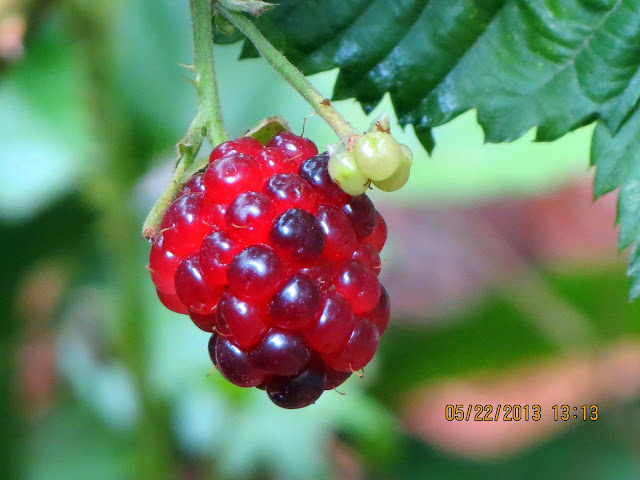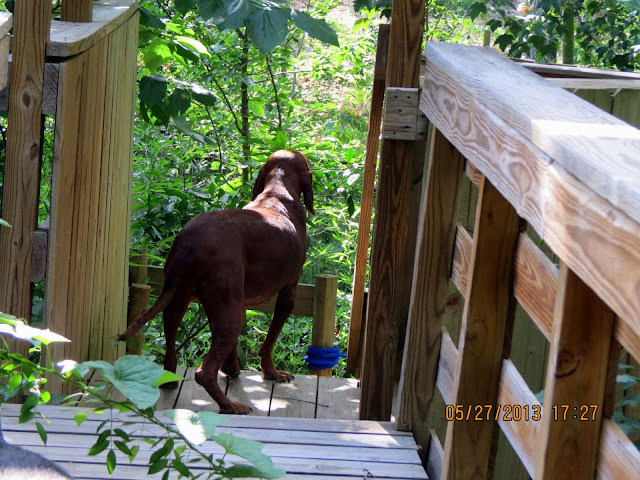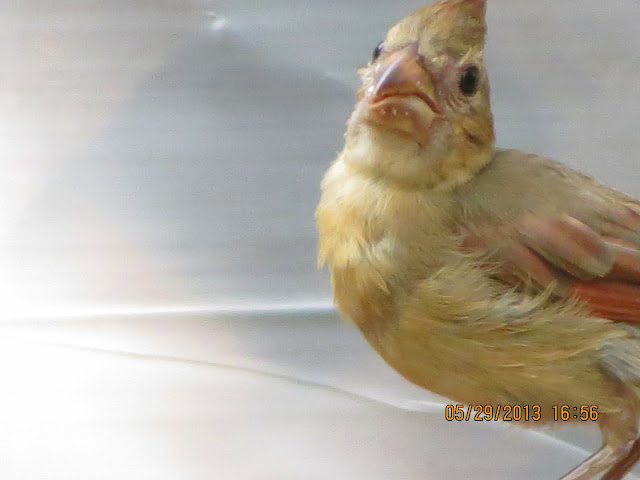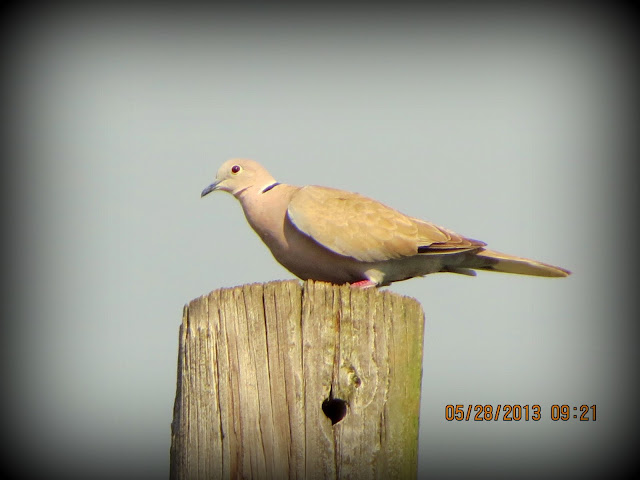I have a berrylicious post for You tonight! June1 signals the arrival of the ripe dewberry days! My dewberry days began about 50 years ago with family treks out to dewberry patches anywhere in South Texas. There was a dress code by Dad: boots, jeans, long sleeved shirts, and a hat (to go out in 100 degree heat). The long sleeves were to help protect from the scratchy thorns on the vines. The boots were to protect from the snakes hiding in the briars. The procedure was to whack the ground in front of every step to scare away the snakes. When arriving at the berry patch, you poke the stick in first and turn it to expose the berries inside. Then you fill up all your buckets with as many of the endless berries as you want! Of course, I ate all I could also, so I went away with purple stains on my mouth, face, fingers and long sleeved shirt! I was always more purple than the other kids (still am!)
As a kid, I wondered why the snakes liked the berries so much that they lived in the berry patches. We never actually saw any back then, but that was because of all the whacking we did. I did not find out until a few years ago that snakes do not eat the berries as I assumed. They eat the mice and other rodents that come for the berries!
In these modern days, I bought the hybrid berries to plant in my garden. They come back every year. They are larger and less seedy than the original Texas berries. They also grow on upward vines so you can see the ground (and/or snakes). No need to carry the stick anymore, wear the boots, jeans or long sleeved shirts to trek miles across the countryside. I just walk outside Kates Cabin, barefoot and in my pjs and fill up the bucket. (I do sometimes still whack the stick just because it was fun). While the cobbler is baking, I make the homemade ice cream (with electricity, not crank). I remember all those old family outings (and whacking my brother with the stick). I remember Moms smiling face looking at all her purple mouthed kids bringing her their buckets of berries (and Dad reassuringly relating to her no snakes this time). The kids played in the wading pool while the cobbler baked. Dad hand cranked the ice cream. The days were good. The crowning moment came after dinner when the cobbler came out. With a large family, it always disappeared. Yes, summer is here.
The rewards are different today. I have the great memories, the great berries, better cobbler than anyone makes and being alone now, I get to eat the whole thing! Enjoy your dewberry photostudy and Welcome to Summer!
http://en.wikipedia.org/wiki/Dewberry
Dewberry
From Wikipedia, the free encyclopedia
The dewberries are a group of species in the genus Rubus, section Rubus, closely related to the blackberries. They are small trailing (rather than upright or high-arching) brambles with berries reminiscent of the raspberry, but are usually purple to black instead of red. Unlike many other Rubus species, dewberries have separate male and female plants (they are dioecious) (Burbank, methods and applications 3, AD 1914).[citation needed]
Dewberries are common throughout most of the Northern Hemisphere, sometimes thought of as a nuisance weed, but the leaves can be used for a tea, and the berries are sweet and edible. They can be eaten raw, or used to make cobbler, jam, or pie.
Around March and April, the plants start to grow white flowers that develop into small green berries. The tiny green berries grow red and then a deep purple-blue as they ripen. When the berries are ripe, they are tender and difficult to pick in any quantity without squashing them. The plants do not have upright canes like some other Rubusspecies, but have stems that trail along the ground, putting forth new roots along the length of the stem. The stems are covered with fine spines or stickers. The berries are sweet and, for many, less seedy than blackberries and worth the scratches and stains that come from picking them.
In the winter the leaves often remain on the stems, but may turn dark red. The leaves are sometimes eaten by the larvae of some Lepidoptera species including peach blossom moths.
I found the following article in the Google Index by: Doyle Driver.
He captures the spirit of the old dewberry days around Houston Area. Doyle Driver is a native Texan reared in Hardeman County and a 40-year resident of Conroe. He can be reached at doyledriver@yahoo.com.
http://www.yourhoustonnews.com/courier/opinion/copperheads-dewberries-and-nature/article_dca2dc06-335a-5c81-a688-e46d95cf09f5.html
This is an excerpt. Please see above link for complete article:
Copperheads, dewberries and nature
For awhile, I refused to give in and pick berries for a dewberry cobbler. Eventually, I succumbed to the
thoughts of a bowl of juicy dewberry cobbler topped with Bluebell Homemade Vanilla. But, it was the
thought of berry juice bubbling through the sugary coated, thin, crisp, brown crust that did me in!
Anyway, after work one warm late-spring afternoon, Pat, the boys and I went berry picking in John and
Marilyn Mayes’ vacant lot in back of River Plantation.
The heat would have been unbearable had it not been for ripe clusters of oversized dewberries awaiting
the harvest. By the end of an hour, we’d picked a couple of gallons, filling our milk cartons to the brim,
so we headed home singing all the way.
After arriving at home, I decided to soak the berries in cold water before storing them in the hydrator
drawer of our refrigerator. Much to my chagrin, tiny worms were floating on the water’s surface. I didn’t
bother to tell Pat and the boys; I just supposed what they didn’t know wouldn’t hurt them. Anyway, no
one was the wiser, and nobody came down with anything — although thoughts of having them “de-
wormed” did enter my mind!
As I became aware of the copper-colored vipers, I began watching for them in our yard. It seemed each time I mowed, at least one or more copperheads were hacked to pieces by the mower. Our Dachshund
was bitten twice at our back door and suffered in misery for days. Had the snakes realized the enemy they
were making, they would have steered clear of him. From that day forward, he was a snake hunter
deluxe; he hated them with a passion. Each spring when the rains come, my thoughts turn to dewberries,
and I long for a fresh dewberry cobbler. Then, my thoughts quickly turn to copperhead snakes, dwelling
within the confines of the berry patch, and I’m thankful for grocers who carry all sorts of berries for
making cobblers.
THE GUARD DOG OF THE BERRIES: LITTLE KING
THE DOG DAYS OF SUMMER HAVE ARRIVED AS WE HIT 96 DEGREES TODAY AND REALLY NO RAIN FOR MONTHS. THERE ARE MORE CLOUDS THAN I HAVE SEEN IN YEARS, BUT THEY DO NOT RAIN ON ME HERE. THE DROUGHT CONTINUES AT RAINBOW CREEK.
THE BLACK QUEEN IN WAITING: FAT SISSY
THE RED QUEEN IS FADING: KAY LONNIE WRAY (AKA MISS AMERICA). SHE CLIMBS THE STAIRWAY TO HER STAGE ONCE MORE FOR AN ENCORE TO HER FANS
SHE IS HEADING BACK DOWN TO GET CLOSER TO HER FANS
SHE LOOKS OUT OVER HER MILLIONS OF WAVING FANS
AND GIVES THEM A BIG BBBBBAAAAAAAAAAUUUUUUUUUUUUU
THE FANS GO WILD WAVING IN THE WIND AS SHE GETS OUT ONE MORE
BBBBBBAAAAAAAUUUUUUUUUUUUUUUUUUUUUUUUUUU
SHE WAGS HER TAIL AS THE FANS GO CRAZY FOR HER
(FAT SISSY SAYS: OH BROTHER, GIVE ME A BREAK)
THE FANS ARE CHEERING HER ON, BUT HER STRENGTH IS FADING. SHE MAKES IT BACK TO HER BED WHERE SHE IS RESTING PEACEFULLY. IT IS DIFFICULT TO FACE THE FACT THAT DOGS DO NOT LIVE AS LONG AS HUMANS. KAY HAS HAD A GOOD LIFE WITH MOM AND ME. WE LOVE OUR DOGS.
PLEASE DON'T EVER TELL HER THAT THE FANS ARE ONLY LOWLY LEAVES ON TREES!
EVEN LOWLY LEAVES ON TREES COUNT AS THEY WAVE WILDLY AT KAY, SHE IS ONE HAPPY DOG!
MIMOSA TREES IN FULL BLOOM ON THE CREEK
UPDATE ON ROCKY RACCOON: ROCKY MAY HAVE COME FROM MEXICO AS THAT DUDE LOVES TACOS! HE IS THE ONLY RESIDENT WHO CONSUMES FAST FOOD. HE GETS 2 TACOS ONCE A WEEK. HERE HE IS STEALING AWAY WITH THE PRIZE. I WILL TRY TO GET A SHOT OF HOW HE HOLDS THEM AND EATS THEM NEXT TIME!
UPDATE ON PRINCE ANOLE~: LOOK WHERE HE SHOWED UP TODAY! ON ONE OF MOMS OLD BIRD ORNAMENTS. DOES THIS GUY HAVE A PERSONALITY OR WHAT? (THE ONLY WAY I KNOW IT IS THE PRINCE IS BY THE MISSING TAIL)!
UPDATE ON THE BABY CARDINALS:
THE BROWN ONE IS THE NEWEST ARRIVAL. THE RED ONE IS ALSO A BABY, ABOUT 3 WEEKS OLDER WITH ALL HIS NEW RED FEATHERS!
...this is brendasue signing off from Rainbow Creek. See You next time. Thanks for stopping by Kates Cabin to visit! I hope one day I can 3D copy you a bowl of hot dewberry cobbler and homemade vanilla ice cream You can enjoy while you view the pics! Can You taste it yet? Love to All
THE TAIL END:
o+o



























































































